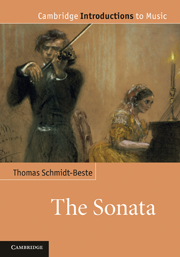Chapter 3 - Functions and aesthetics
Published online by Cambridge University Press: 05 April 2013
Summary
According to William Newman, one of the defining characteristics of the sonata is its nature as ‘absolute’ music – music, therefore, that is neither firmly associated with a specific function (such as music for the liturgy, for the stage or for dancing) nor tied by means of verbal additions (titles, programmes, etc.) to specific ‘meanings’. In the words of the nineteenth-century music critic Eduard Hanslick, sonatas are ‘forms of sound in motion’ (tönend bewegte Formen) and nothing else. However, while this can be a useful means of distinguishing sonatas (or, at least, most sonatas) from other genres of instrumental music – such as the dance suite in the seventeenth and early eighteenth centuries and the lyrical piano piece or the fantasia in the nineteenth – the claim that the sonata was never more than a ‘sound piece’ written for its own sake is exaggerated and potentially misleading. If it was not firmly tied to specific functions or contexts, it could at least be strongly associated with them; and ‘programme sonatas’, while certainly not the rule, are still too numerous to be altogether ignored.
Locations and occasions
If it is true that sonatas were rarely composed for certain occasions, it is undoubtedly also true that they were played at certain occasions. The first context which deserves mention here is the church.
- Type
- Chapter
- Information
- The Sonata , pp. 173 - 192Publisher: Cambridge University PressPrint publication year: 2011

